Canada's top 10 weather stories for 2014: chapter 4
4. The Nightmare Before, During and After Christmas
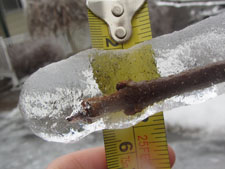
The weekend before Christmas 2013 a vigorous winter storm coated parts of eastern Canada with a thick cocktail of snow, ice pellets, rain and freezing rain that plunged large parts of the region into days of cold and darkness. Restoration of full utilities and property clean-up continued well into 2014. At the time, a thick glaze left roads and sidewalks slick and dangerous; it also knocked down hydro lines, leaving over 500,000 people without power. In addition to wreaking havoc in Canada’s largest city (Toronto), it crippled North American transportation at one of the busiest travel times of the year. As damaging as it was, comparisons to the deadly ice storm that entombed much of Eastern Canada in 1998 weren’t even close with the earlier storm killing more than two dozen people and leaving another four million in the dark.
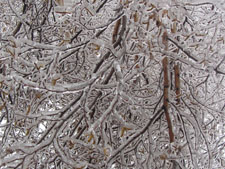
Though picturesque, the Christmas storm created extremely dangerous conditions as fallen hydro lines intertwined with broken tree limbs that dangled across streets and property. The affected area extended from Lake Huron, across the Greater Toronto Area, east along Highway 401 to Cornwall, through Quebec’s Eastern Townships and Montérégie region, and across the central Maritimes centred on the Bay of Fundy. The epicentre of the freezing rain was in southern Ontario between Niagara and Trenton, where between 20 and 30 mm fell - more than two-year’s worth in two days.
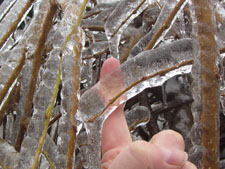
The complex weather system originated in Texas and sent warm moist air northward above a shallow surface layer of cold air lying in wait across eastern Canada. The first wave spread continuous mixed precipitation into southern Ontario late on December 20 and through the morning of December 21. A few hours of intermittent precipitation followed before a more potent storm tapping loads of moisture from the Gulf of Mexico arrived late in the afternoon and persisted into the next day. At Toronto Pearson International Airport, an impressive 43 hours of freezing rain and drizzle occurred between the evening of December 20 and late afternoon on December 22, while temperatures remained fairly constant hovering around the freezing mark for 60 hours. Trenton registered 55 hours of freezing precipitation, while farther north - between Kincardine and Ottawa - snow and ice pellets fell with peaks of 18 cm of snow in Ottawa and 15 cm of ice pellets in Cornwall.
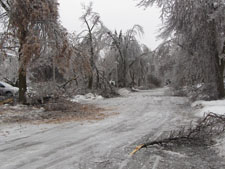
In southwestern Ontario and along the north shore of Lake Erie, it was all rain with totals between 40 and 70 mm. In Montréal and Saint-Hyacinthe, it was mostly snow totalling 11 cm and 20 cm respectively while the Gaspésie received up to 65 cm of snow with strong winds. Freezing rain totals in Quebec ranged from 15 to 25 mm through the Richelieu Valley and in Sherbrooke. In New Brunswick, freezing rain coated surfaces with 10 to 30 mm of ice, augmented by a series of fierce storms between Christmas and a few days after New Years that dumped 30 to 70 cm of snow and freezing rain. NB Power called that two-week period of nasty weather the most damaging and challenging in decades.
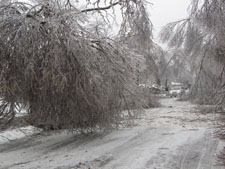
Because temperatures remained below freezing in the wake of the storm, there was little natural melting. Wind strengths also picked up resulting in ice-ladened tree branches snapping, crackling and bringing down power lines for a week afterward. Over half of those plunged into darkness were in the Toronto region, with Toronto Hydro calling it one of the largest ice storms in history. The icy weather left the city with a fractured transit system, a water pumping station out of commission and two major hospitals running on back-up generators. Community centres were opened to warm and feed thousands of citizens, while retailers struggled to remain open through one of the busiest and most profitable shopping weeks of the year.
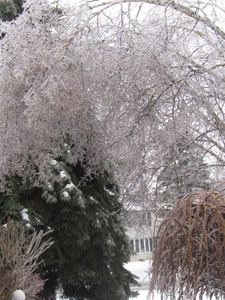
In Quebec, 54,000 people lost power - most living in the Eastern Townships, Montérégie and Montréal. In the Maritimes, the hardest hit area centred on Rothesay and St. Stephen. In total, 88,000 residents faced off-and-on power interruptions; some as many as six times. Hydro trucks from Michigan to Maine and as far west as Manitoba arrived to help eastern Canada, but restoring power proved to be slow and difficult as utility crews trudged through deep snow, crossed slippery surfaces or manoeuvred debris piles to reach damaged areas. Full service wasn’t back in New Brunswick for 11 days. In southern Ontario, more than 100,000 people in homes, businesses and farms were still without power on Boxing Day.
The storm was thought to have played a factor in fatalities in Ontario and Quebec, including six fatal highway crashes and five deaths due to carbon monoxide poisoning resulting from unsafe heating methods. Additional costs from worker overtime, spoiled food, and damaged homes, vehicles and public infrastructure is thought to exceed hundreds of millions of dollars. Irreplaceable is the loss of trees. In Toronto alone, some streets lost between 50 and 80 per cent of their mature canopy leaving large holes in the city’s urban forest.